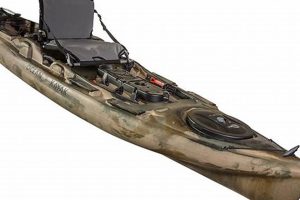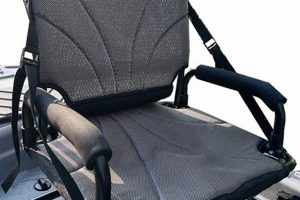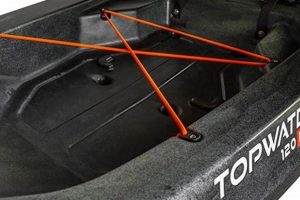A customizable storage solution constructed from a common plastic crate, often used by anglers to organize and transport gear while kayak fishing. These crates can be adapted with rod holders, tackle boxes, and other accessories to create a personalized on-the-water workstation. An example includes a crate outfitted with PVC pipe rod holders and attached to a kayak using bungee cords or straps.
Adaptable and cost-effective, this approach to tackle organization offers significant advantages for kayak anglers. It maximizes limited space on a kayak, keeping essential equipment readily accessible while maintaining stability. Furthermore, the modular nature allows for customization based on individual fishing styles and preferences. While the exact origins are difficult to pinpoint, the practice likely evolved from the broader trend of anglers seeking efficient and affordable ways to organize their gear, leveraging the readily available and durable milk crate.
This article will explore various methods for constructing and outfitting such systems, covering materials, tools, and techniques for creating a personalized fishing platform. Further discussion will include considerations for mounting, safety precautions, and popular modifications.
Tips for Crate Customization and Kayak Integration
Careful planning and execution are crucial for creating a functional and safe on-board crate system. The following tips offer guidance on optimizing crate modifications and secure kayak integration.
Tip 1: Plan the layout. Before drilling or attaching any components, carefully consider the desired layout. Mapping out rod holder placement, tackle box integration, and other accessories ensures efficient space utilization and avoids unnecessary modifications.
Tip 2: Choose appropriate mounting hardware. Stainless steel hardware is recommended due to its corrosion resistance in marine environments. Use appropriate fasteners for the kayak’s construction material and the crate’s plastic composition.
Tip 3: Secure mounting. Ensure the crate is securely fastened to the kayak to prevent shifting or detachment during paddling and fishing. Strategic placement of mounting points enhances stability and minimizes interference with paddling strokes.
Tip 4: Prioritize stability. Weight distribution is critical for kayak stability. Avoid overloading one side of the kayak and distribute gear evenly within the crate. Consider lower center of gravity when adding equipment.
Tip 5: Utilize zip ties and bungee cords. These versatile tools can be employed to secure gear, manage loose lines, and provide additional attachment points for accessories.
Tip 6: Consider drainage. Drill drainage holes in the crate’s bottom to prevent water accumulation and reduce weight. This is especially important in saltwater environments.
Tip 7: Customize rod holders. PVC pipe, cut to appropriate lengths and angles, provides an affordable and customizable solution for rod storage. Ensure rod holders are securely attached to the crate and positioned for easy access.
By adhering to these guidelines, anglers can create a customized crate system that enhances fishing efficiency, optimizes space utilization, and ensures a safe and enjoyable kayaking experience.
These practical tips provide a starting point for crate customization and kayak integration. Further exploration of specific modifications and techniques will be detailed in subsequent sections.
1. Customization
Customization is central to the appeal of the DIY kayak fishing milk crate system. It transforms a standard, utilitarian item into a personalized fishing platform tailored to individual needs and preferences. This adaptability allows anglers to optimize their kayak’s limited space for maximum efficiency and enjoyment.
- Rod Holders
Custom rod holders are a fundamental aspect of crate modification. Anglers can craft holders from PVC pipe, cutting and angling them to suit specific rod types and fishing styles. For example, a fly fisherman might incorporate angled holders for easy access, while a trolling angler might prefer vertical holders for secure rod storage. This customization eliminates the need for expensive, pre-fabricated rod holders and allows for precise placement on the crate.
- Tackle Storage
Integrating tackle storage directly into the crate is a key customization feature. Small tackle boxes, trays, and even repurposed containers can be attached to the crate’s interior or exterior using zip ties, screws, or adhesive. A bass angler might create compartments for various lure types, while a saltwater angler might prioritize storage for different leader materials. This personalized organization streamlines tackle management and maximizes efficiency on the water.
- Accessory Mounting
Beyond rod holders and tackle storage, customization extends to mounting other essential accessories. Fish finders, GPS units, cutting boards, and even cup holders can be integrated into the crate system. For example, a kayak angler might mount a fish finder directly to the crate for optimal viewing, enhancing their ability to locate fish. This adaptability transforms the milk crate into a comprehensive fishing station.
- Aesthetics and Personalization
While functionality is paramount, customization also allows for personal expression. Anglers can paint their crates, add stickers, or incorporate unique design elements. This personalization adds a touch of individuality to the kayak and fosters a sense of ownership and pride in the DIY creation. Examples include camouflage paint jobs for blending into the environment or vibrant colors for increased visibility.
Through these various customization options, the DIY kayak fishing milk crate system becomes more than just a storage solution; it becomes an extension of the angler’s fishing style and preferences, contributing significantly to an enhanced and personalized on-the-water experience.
2. Secure Mounting
Secure mounting is paramount for a successful DIY kayak fishing milk crate system. A poorly secured crate can shift during paddling or fishing, compromising stability, hindering access to gear, and potentially causing equipment loss. The connection between secure mounting and the overall system’s effectiveness is direct and critical. A stable crate maximizes the benefits of customization, ensuring readily accessible gear and a balanced kayak. Conversely, an unstable crate negates these benefits, creating frustration and potentially hazardous situations. Consider a scenario where a kayak angler hooks a large fish; a securely mounted crate provides a stable platform for the fight, while a loose crate could shift, jeopardizing balance and potentially leading to capsizing.
Several factors influence secure mounting. The type of kayak material (plastic, fiberglass, etc.) dictates appropriate fastening methods. Straps, bungee cords, and screws offer varying levels of security and adaptability. The crate’s position on the kayak also impacts stability. Positioning the crate too far forward or aft can affect the kayak’s trim and balance. Distributing weight evenly within the crate further enhances stability. For instance, placing heavier items at the bottom of the crate lowers the center of gravity, improving overall balance. Using multiple attachment points distributes stress and reduces the risk of individual fasteners failing. Durable, marine-grade hardware is essential to withstand the corrosive marine environment and ensure long-term reliability.
Understanding the importance of secure mounting is crucial for maximizing the functionality and safety of a DIY kayak fishing milk crate system. Proper mounting techniques, appropriate hardware selection, and strategic weight distribution are essential elements for a successful and enjoyable kayaking experience. Failure to address these factors can lead to instability, equipment damage, and potentially dangerous situations on the water. Therefore, prioritizing secure mounting ensures the system functions as intended, providing a stable and efficient fishing platform.
3. Accessibility
Accessibility is a critical design consideration for a functional kayak fishing milk crate system. Efficient access to tackle, tools, and other equipment directly impacts fishing success and overall enjoyment on the water. A well-designed system prioritizes ergonomic placement and ease of retrieval, minimizing time spent searching for items and maximizing time spent fishing. Cause and effect are directly linked: a readily accessible setup allows for quick lure changes, efficient line management, and a seamless transition between fishing techniques. Conversely, a poorly designed system hinders these processes, leading to frustration and lost fishing opportunities.
Consider a scenario where an angler spots a school of feeding fish. With an accessible crate system, the angler can quickly select the appropriate lure, change lines if necessary, and present the offering to the fish with minimal delay. This rapid response time significantly increases the chances of a successful hookup. Conversely, if essential gear is buried deep within a cluttered crate, the opportunity might be lost while the angler searches for the right equipment. This example illustrates the practical significance of accessibility in a real-world fishing scenario.
Several factors contribute to accessibility. Strategic placement of frequently used items within easy reach minimizes movement and reduces the risk of losing balance. Utilizing clear containers or labeling compartments allows for quick identification of contents. Furthermore, incorporating features like open-top compartments or pull-out trays streamlines access and reduces the need to rummage through the crate. Prioritizing accessibility in the design phase of a DIY kayak fishing milk crate system significantly enhances the overall fishing experience, contributing to efficiency, enjoyment, and ultimately, success on the water. Addressing this crucial aspect transforms a simple storage container into a highly functional and effective fishing platform.
4. Stability
Stability is paramount when kayak fishing, particularly with a DIY milk crate system. A stable platform is essential for casting, reeling, landing fish, and overall safety. Compromised stability can lead to capsizing, equipment loss, and potentially dangerous situations. The relationship between a DIY milk crate system and kayak stability is intertwined; the crate’s weight, placement, and attachment method directly impact the kayak’s balance and performance. Understanding these factors and their interplay is crucial for a safe and enjoyable fishing experience.
- Weight Distribution
Proper weight distribution within the crate and on the kayak is fundamental for stability. Distributing heavier items low in the crate and evenly across the kayak’s width lowers the center of gravity, enhancing stability. Conversely, concentrating weight in one area or placing heavy items high on the crate raises the center of gravity, increasing the risk of capsizing. For example, placing batteries, tackle boxes, and anchor closer to the bottom creates better stability. Uneven weight distribution makes turning and maneuvering challenging even in calm conditions.
- Crate Placement
The crate’s location on the kayak significantly influences stability. Positioning the crate too far forward or aft can negatively impact the kayak’s trim, making it prone to tipping. Generally, positioning the crate behind the seat, near the center of the kayak, provides optimal balance. Consider a kayak angler casting from a seated position; a centrally located crate provides a stable platform, whereas a crate positioned too far back could cause the kayak to tip backward during the cast.
- Secure Attachment
A securely attached crate is essential for maintaining stability. A loose or shifting crate can disrupt balance, especially during abrupt movements like hooking a fish or encountering rough water. Using multiple attachment points with sturdy straps or hardware ensures the crate remains firmly in place, minimizing the risk of shifting or detachment. For instance, using high-strength straps connected to multiple anchor points on the kayak prevents the crate from sliding or tipping, even under stress.
- Crate Size and Shape
The crate’s dimensions also influence stability. A large, bulky crate can create wind resistance and increase the likelihood of capsizing, particularly in windy conditions. Choosing a crate size appropriate for the kayak’s dimensions and the angler’s needs is essential. A low-profile crate minimizes windage and reduces the impact on the kayak’s overall balance. For example, a smaller crate for a smaller kayak with less gear contributes to better stability. Oversized crates can interfere with paddling and make the kayak feel top-heavy.
These factors, when considered carefully, contribute to a stable and safe kayak fishing platform. Neglecting these elements can compromise stability, hindering fishing performance and potentially creating hazardous situations on the water. A stable kayak enhances angler confidence, allows for efficient fishing techniques, and ultimately contributes to a more enjoyable and successful experience. Prioritizing stability in the design and implementation of a DIY milk crate system is paramount for maximizing safety and optimizing performance on the water.
5. Durability
Durability is a critical factor in the effectiveness of a DIY kayak fishing milk crate system. Exposure to the marine environment, including saltwater, UV radiation, and physical stress, necessitates a robust and resilient setup. A durable system ensures long-term functionality, minimizes maintenance, and contributes to a safe and reliable fishing platform. This discussion will explore the key facets of durability as they relate to these customized crate systems.
- Material Selection
The crate itself, typically high-density polyethylene (HDPE), offers inherent durability and resistance to weathering. However, added components, like hardware and accessories, require careful consideration. Stainless steel or corrosion-resistant metals are essential for fasteners, rod holders, and other attachments. Using non-corrosive materials prevents rust and degradation, ensuring long-term structural integrity. For example, opting for stainless steel screws over galvanized screws prevents rust stains and ensures the system remains securely fastened over time. Choosing marine-grade materials, specifically designed for harsh marine conditions, maximizes the system’s lifespan.
- Construction Techniques
Proper construction techniques significantly influence durability. Securely fastening components with appropriate hardware and reinforcing stress points enhances the system’s ability to withstand the rigors of kayak fishing. For instance, reinforcing rod holder mounts with additional bracing prevents them from loosening or breaking under the stress of a fighting fish. Using UV-resistant zip ties and marine-grade adhesives ensures components remain securely attached despite prolonged sun exposure and saltwater immersion. Attention to detail during construction minimizes the risk of failure and maximizes the system’s lifespan.
- Maintenance and Care
Even with durable materials and robust construction, regular maintenance contributes to a system’s longevity. Rinsing the crate with fresh water after each use removes salt and debris, preventing corrosion and material degradation. Inspecting hardware and fasteners for signs of wear and tear allows for timely replacements, preventing potential failures on the water. Storing the crate in a protected environment, out of direct sunlight, minimizes UV damage and extends the lifespan of plastic components. For example, storing the crate indoors and giving it a rinse after each use dramatically improves longevity and durability.
- Impact Resistance
The crate system’s ability to withstand impacts is crucial. Collisions with docks, rocks, or other obstacles are common occurrences in kayak fishing. A durable crate, coupled with secure mounting, minimizes the risk of damage during such impacts. Reinforcing the crate’s corners or adding protective padding can further enhance impact resistance. For example, adding rubber bumpers to the crates bottom provides padding against accidental impacts, further protecting stored gear from damage and preserving the systems integrity. This added protection minimizes the risk of cracking or breakage, ensuring the system remains functional despite occasional bumps and scrapes.
Durability, therefore, is not merely a desirable feature; it is a fundamental requirement for a successful DIY kayak fishing milk crate system. By carefully selecting materials, employing proper construction techniques, and adhering to a regular maintenance schedule, anglers can create a system that withstands the demanding marine environment and provides years of reliable service. This attention to durability ultimately enhances safety, minimizes maintenance, and maximizes the enjoyment of kayak fishing.
Frequently Asked Questions
Addressing common inquiries regarding the construction and utilization of customized crate systems for kayak fishing.
Question 1: What type of milk crate is best suited for kayak fishing?
Heavy-duty, high-density polyethylene (HDPE) crates are recommended for their durability and resistance to weathering. Crates with reinforced corners and thicker walls offer increased strength and impact resistance.
Question 2: What is the most secure method for attaching a milk crate to a kayak?
Multiple attachment points using sturdy straps or stainless steel hardware provide the most secure mounting. Distributing the attachment points across the crate and kayak enhances stability and prevents stress concentration.
Question 3: How can crate systems impact kayak stability?
Weight distribution and crate placement significantly influence kayak stability. Distributing weight evenly within the crate and positioning it near the kayak’s center enhances balance and reduces the risk of tipping.
Question 4: What are the essential accessories for a kayak fishing crate system?
Essential accessories include rod holders, tackle storage solutions, and a secure mounting system. Additional accessories, such as fish finders, GPS units, and cutting boards, can be added based on individual needs and preferences.
Question 5: How can one prevent a milk crate system from interfering with paddling?
Careful crate placement and a streamlined design minimize interference with paddling. Positioning the crate behind the seat and avoiding excessive bulkiness allows for unobstructed paddle strokes.
Question 6: What maintenance is required for a kayak fishing milk crate system?
Regular rinsing with fresh water after each use removes salt and debris, preventing corrosion. Periodic inspection of hardware and fasteners ensures timely replacement of worn components, maintaining system integrity.
Careful consideration of these frequently asked questions contributes to a safe, functional, and enjoyable kayak fishing experience. Addressing potential challenges proactively ensures the customized crate system enhances, rather than hinders, time on the water.
The subsequent section will provide a step-by-step guide for constructing a personalized kayak fishing crate system.
Conclusion
Customizable kayak fishing milk crate systems offer anglers a practical and adaptable approach to gear organization and access. Exploration of construction techniques, material selection, mounting strategies, and customization options reveals the potential for creating personalized on-the-water workstations. Key considerations include stability, accessibility, durability, and integration with the kayak’s design, influencing both fishing effectiveness and overall safety. Careful planning and execution are essential for maximizing benefits and minimizing potential drawbacks.
The adaptability and affordability of these systems empower anglers to tailor their kayak fishing experience to individual needs and preferences. Continued innovation in materials, techniques, and accessories promises further refinement and evolution of customizable kayak fishing milk crate systems, enhancing the pursuit of this popular sport.






